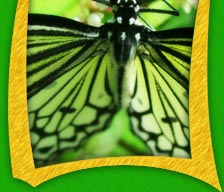|
Butterflies, and butterfly lovers, are everywhere.
Keep these fun facts in mind the next time a Butterfly flutters
by:
- People who study or collect butterflies (or the
closely related moths) are called lepidopterists.
- Some butterflies
tend to need more soduim than nectar can give them so they will
sometimes land on humans who are sweating.
- There are between 15,000
and 20,000 species of butterflies worldwide.
- Some butterflies
can migrate hundreds of miles.
- Adult butterflies do not get bigger
with age.
- Butterflies taste their food through their feet.
- Butterflies use their antennas to smell.
|
 Photo: Emily Richardson
Photo: Emily Richardson |
BUTTERFLY GARDENING TIPS
With so many people fascinated by butterflies it’s not
wonder that butterfly gardening is becoming a very popular hobby. A
butterfly garden will brighten up your backyard with beautiful flowers
and plants, not to mention the amazing butterflies that will come visit
your garden. It’s a great way to add some nature and beauty to
this urban environment we live in. These gardens are also beneficial
to the butterflies as it provides them with much needed habitat that
seems to be disappearing.
Here are some tips on creating and maintaining a butterfly
garden:
- Research which butterflies are native to
your area
- Plant your garden in full sun -
Flowering plants need lots of sun and butterflies need sun to warm
their bodies for flight.
- Plant butterfly-attracting flowers -
Flowers should have strong scents and bright colors. Also, use
native plants to attract butterflies in your area. Visit
the links section to find information on matching plants with
butterfly species.
- Use host plants in the garden -
These are plants that emerging caterpillars can eat.
- Do not use chemical pesticides
Resources for this article
provided by Wikipedia & butterfliesandmoths.org (Opler,
Paul A., Harry Pavulaan, Ray E. Stanford, Michael Pogue, coordinators.
2006. Butterflies and Moths of North America. Bozeman, MT: Mountain
Prairie Information Node.)
|










